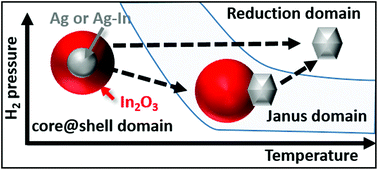Our official English website, www.x-mol.net, welcomes your
feedback! (Note: you will need to create a separate account there.)
Tracking the restructuring of oxidized silver–indium nanoparticles under a reducing atmosphere by environmental HRTEM
Nanoscale ( IF 5.8 ) Pub Date : 2017-08-01 00:00:00 , DOI: 10.1039/c7nr02986a Julien Ramade 1, 2, 3, 4, 5 , Cyril Langlois 1, 2, 6, 7, 8 , Michel Pellarin 1, 2, 3, 4, 5 , Laurent Piccolo 9, 10, 11, 12 , Marie-Ange Lebeault 1, 2, 3, 4, 5 , Thierry Epicier 1, 2, 6, 7, 8 , Mimoun Aouine 1, 2, 6, 7, 8 , Emmanuel Cottancin 1, 2, 3, 4, 5
Nanoscale ( IF 5.8 ) Pub Date : 2017-08-01 00:00:00 , DOI: 10.1039/c7nr02986a Julien Ramade 1, 2, 3, 4, 5 , Cyril Langlois 1, 2, 6, 7, 8 , Michel Pellarin 1, 2, 3, 4, 5 , Laurent Piccolo 9, 10, 11, 12 , Marie-Ange Lebeault 1, 2, 3, 4, 5 , Thierry Epicier 1, 2, 6, 7, 8 , Mimoun Aouine 1, 2, 6, 7, 8 , Emmanuel Cottancin 1, 2, 3, 4, 5
Affiliation

|
Multimetallic nano-alloys display a structure and consequently physicochemical properties evolving in a reactive environment. Following and understanding this evolution is therefore crucial for future applications in gas sensing and heterogeneous catalysis. In view hereof, the structural evolution of oxidized Ag25In75 bimetallic nanoparticles under varying H2 partial pressures (PH2) and substrate temperatures (Ts) has been investigated in real-time through environmental transmission microscopy (E-TEM) while maintaining the atomic resolution. Small Ag25In75 bimetallic nanoparticles, produced by laser vaporization, are found (after air transfer) to contain an indium–oxide shell surrounding a silver-rich alloyed phase. For high PH2 and Ts, the direct reduction of the indium oxide shell, immediately followed by the melting or the diffusion onto the carbon substrate of the reduced indium atoms, is found to be the dominant mechanism. This reduction is concomitant with the growth of the core, indicating a partial diffusion of indium atoms from the shell towards the particle volume. The “surviving” particles therefore consist of a silver–indium alloy, very stable and remarkably resistant against oxidation contrary to native clusters. Interestingly, in the (PH2, Ts) space, the transition from “soft” (core–shell particles for low (PH2, Ts) values) to “strong” reduction conditions (silver-rich alloys for high (PH2, Ts) products) defines an intermediate domain where the preferred formation of Janus structures is detected. These results are discussed in terms of thermodynamic driving forces in relation to alloying and interface energies. This work shows the potential of high-resolution ETEM for unravelling the mechanisms of nanoparticle reorganization in a chemically reactive environment.
中文翻译:

通过环境HRTEM跟踪还原气氛下氧化的银-铟纳米粒子的重组
多金属纳米合金显示出结构,因此在反应性环境中表现出物理化学性质。因此,跟踪和理解这种演变对于将来在气体传感和非均相催化中的应用至关重要。鉴于此,已经通过环境透射显微镜(E-TEM)实时研究了在变化的H 2分压(P H 2)和衬底温度(T s)下,氧化的Ag 25 In 75双金属纳米颗粒的结构演变。保持原子分辨率。小银25在75通过激光蒸发产生的双金属纳米粒子(在空气转移后)被发现包含一个氧化铟壳,该氧化铟壳围绕着富银合金相。对于高的P H 2和T s,发现氧化铟壳的直接还原,然后是还原的铟原子的熔化或扩散立即扩散到碳基材上,是主要的机理。这种减少伴随着核的生长,表明铟原子从壳向粒子体积的部分扩散。因此,“幸存”颗粒由银-铟合金组成,与天然簇相反,银-铟合金非常稳定并且具有显着的抗氧化性。有趣的是,在(P H 2(T s)空间,从“软”(低(P H 2,T s)值的核壳颗粒)到“强”还原条件(高(P H 2,T s)的富银合金)的过渡产品)定义了一个中间域,在其中检测到Janus结构的首选形成。根据与合金化和界面能有关的热力学驱动力讨论了这些结果。这项工作显示了高分辨率ETEM在化学反应环境中揭示纳米颗粒重组机理的潜力。
更新日期:2017-09-21
中文翻译:

通过环境HRTEM跟踪还原气氛下氧化的银-铟纳米粒子的重组
多金属纳米合金显示出结构,因此在反应性环境中表现出物理化学性质。因此,跟踪和理解这种演变对于将来在气体传感和非均相催化中的应用至关重要。鉴于此,已经通过环境透射显微镜(E-TEM)实时研究了在变化的H 2分压(P H 2)和衬底温度(T s)下,氧化的Ag 25 In 75双金属纳米颗粒的结构演变。保持原子分辨率。小银25在75通过激光蒸发产生的双金属纳米粒子(在空气转移后)被发现包含一个氧化铟壳,该氧化铟壳围绕着富银合金相。对于高的P H 2和T s,发现氧化铟壳的直接还原,然后是还原的铟原子的熔化或扩散立即扩散到碳基材上,是主要的机理。这种减少伴随着核的生长,表明铟原子从壳向粒子体积的部分扩散。因此,“幸存”颗粒由银-铟合金组成,与天然簇相反,银-铟合金非常稳定并且具有显着的抗氧化性。有趣的是,在(P H 2(T s)空间,从“软”(低(P H 2,T s)值的核壳颗粒)到“强”还原条件(高(P H 2,T s)的富银合金)的过渡产品)定义了一个中间域,在其中检测到Janus结构的首选形成。根据与合金化和界面能有关的热力学驱动力讨论了这些结果。这项工作显示了高分辨率ETEM在化学反应环境中揭示纳米颗粒重组机理的潜力。







































 京公网安备 11010802027423号
京公网安备 11010802027423号